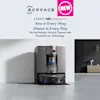Robot Vacuums
Save time and effort with the best range of Robot Vacuums in Australia online and in store at The Good Guys. Get a good deal on leading brands including iRobot , Ecovacs , Dyson and Samsung . Robot Vacuums are automatic using smart technologies to map and adapt to rooms and can be programmed and controlled from a Smart Phone . Some even come with self-emptying functions that automatically empty their dirt and dust into a specially designed receptacle to keep cleaning without any attention, and come with advanced sensors to avoid dangerous edges like stairs. Whatever the brand, budget or features, get the right Robot Vacuum at the best price with The Good Guys.
Wish Vacuuming was easier? Find out more about Robot Vacuums.
Robot Vacuums are unlike any other Vacuum Ceaners on the market. We answer the most frequently asked questions about Robot Vacuums to help familiarise you with the wonderful world of automated cleaning.
Robot Vacuums are a small, rechargeable vacuuming unit designed to clean automatically around the home guided by sensors and cameras. They generally have a small, low profile that allows them to vacuum underneath furniture.
Most Robot Vacuums can connect to a home Wi-Fi network making them easy to track and program from a Smart Phone or Tablet, allowing automatic firmware updates for improved performance and features. You can also schedule Robot Vacuums to clean at certain times of the day or set up virtual cleaning boundaries to keep them cleaning in a specific area or away from others.
Robot Vacuums tend to be better as a supporting second Vacuum, rather than a replacement for a Stick, Barrel or Upright Vacuum. They can reduce the need for more frequent and thorough manual vacuuming by running daily in between cleans. Although a Robot Vacuum will clean autonomously it will still need to be regularly emptied, have its filter changed and brushes cleaned.
In general, a Robot Vacuum will do a good job cleaning hard floors while running on a daily cleaning cycle. They are less efficient at cleaning in corners or along walls, so those areas need separate cleaning even if the home mostly has hard flooring.
Robot Vacuums can also clean carpet although their small size doesn't provide them with a lot of suction power. Even if the carpet looks clean the lower suction power will probably only achieve a surface clean rather than a deeper one. Over time this can potentially damage a carpet or rug so make sure to still give carpets and rugs a good clean with a larger vacuum from time to time.
If you have pets around the house some Robot Vacuums are great for cleaning up cat and dog fur. Of course this doesn't mean pets will get along with it, so it may be worth testing it with them before leaving a Robot Vac and pets unsupervised together.
Robot Vacuums incorporate a range of sophisticated technology like cameras, stair and edge detection, navigation software and Wi-Fi integration to help them navigate and clean at home. Although they will likely bump into walls and tables when you first set them loose, they generally get better at avoiding obstacles over time as they map the layout of each room as it cleans.
Most Robot Vacuums will send out a notification if it gets stuck, blocked or requires assistance. If it's Wi-Fi enabled, it can notify you directly on a mobile phone or Smart Home system through a manufacturers app. Robot Vacuums will get stuck from time to time on stray shoelaces, rug tassels, charging cables and underneath lounges so if possible keep obstacles clear off the floor. Some Robot Vacuums can get stuck moving from a hardwood floor to a rug or carpet, so test that out before letting it go if possible.
Most Robot Vacuums are Smart Home enabled meaning that they can connect to and communicate with other devices over local Wi-Fi. These can be controlled and programmed on an app on a smartphone or tablet. We recommend checking the app is easy to use and includes all the features you want before buying. You should be able to turn the Robot on and off, pause it and program it to start cleaning at certain times, along with accessing or programming cleaning maps, a cleaning log, battery status and providing helpful notifications.
Make sure the Robot Vacuum has a large enough battery to clean home without having to recharge too often. Automatic docking and stair detection features are standard across most models and will ensure your device is always charged and avoids potentially damaging falls. Virtual walls can help keep the Robot vac away from certain areas like pet food bowls.
Some Robot Vacuums can automatically empty themselves into a special bin station Accessory, which will save time on emptying manually and be cleaner to a home overall.
































